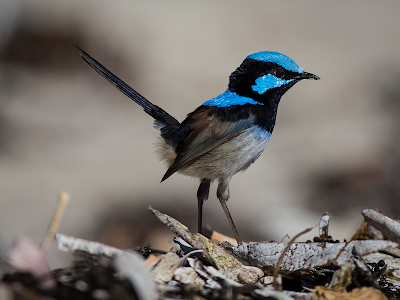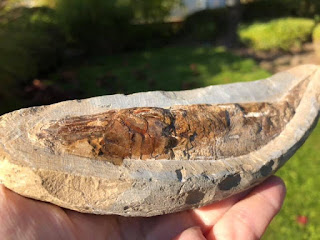 |
| Puntledge Elasmosaur found by Mike Trask |
This specimen was found by Mike Trask and his daughter in the winter of 1988 while fossil collecting along the Puntledge River. While he couldn't have known it at the time, it was this discovery and those that followed that would spark a renewed interest in palaeontology on Vancouver Island and the province of British Columbia.
Mike had foraged ahead, adding chalk outlines to interesting fossil and nodules in the 83 million-year-old shales along the riverbank. His daughter, Heather, was looking at the interesting features he had just outlined when they both noticed some tasty blocks and concretions in situ just a few meters away. Taking a closer look, they were thrilled to discover that they held the bones of a large marine reptile.
It was Betsy who'd written up the incomplete specimen of fossil turtle, Desmatochelys cf. D. lowi — Reptilia: Chelonioidea — found by Richard Bolt, VIPS, in the shales of the Trent River Formation along the Puntledge River in the early 1990s. Dr. Nicholls wrote up the paper and published in the Canadian Journal of Earth Sciences in 1992.
At that time, it was the first documented account of a Cretaceous marine vertebrate from the Pacific coast of Canada, which shows you how much we've learned about our Pacific coast in just the last few years.
The Desmatchelys find inspired the 1999 BCPA Symposium conference logo. Every second year, the BCPA hosts a symposium. The 1999 conference at UBC was the first time the Vancouver Paleontological Society had hosted a BCPA conference. The conference abstract was graced with a trilobite embedded within a turtle, celebrating recent significant contributions to Canadian palaeontology.
 |
| Elasmosaur skull and teeth found by Mike Trask |
When the bones were fully excavated, this 15-meter marine beauty underwent a year of preparation to reveal the skeleton you see here. You can visit the fully prepped specimen and see the articulated bones beneath a glass case in the Courtenay Museum on Vancouver Island.
The Puntledge Elasmosaur has graced the cover of Canada's stamps and was voted as British Columbia's Provincial Fossil in 2019. This honour has the Puntledge Elasmosaur cozied up to other provincial symbols and emblems that include the Pacific Dogwood, Jade, the Steller's Jay, Western Red Cedar, Spirit Bear and Pacific Salmon. The runner-up for BC's Provincial Fossil was Shonisaurus sikanniensis, a massive 21-metre ichthyosaur found in Triassic outcrops in northern British Columbia. That beauty is a worthy reminder of what hunted in our ancient oceans some 220 million years ago.
 |
| BCPA Symposium / Heidi Henderson, Mike Trask, Adam Melzak |
Two of his students were Ann and Joe Zanbilowitz. With the classroom portion of the course finished up, the group set out for a fossil expedition on the Puntledge River. Within five minutes of their search, Joe found a few small articulated vertebrae that we now know to be the type specimen of the mosasaur, Kourisodon puntledgensis. That find, along with some of the other paleontological goodies from the area, prompted the formation of the Vancouver Island Palaeontological Society from an idea to a registered society in 1992. By 1993 membership had grown from a dozen to 250.
In 1992, the Vancouver Island Palaeontological Society passed a motion to encourage the formation of a provincial umbrella group to act as an advocate to promote interaction amongst various paleontological organizations. Through the efforts of Mike Trask, Dan Bowen, Rolf Ludvigsen and others, the first meeting of the Board of Directors of the B.C. Paleontological Alliance was held in 1993.
 |
| Mike Trask hiking up at Landslide Lake, British Columbia |
In 1995, the Victoria Palaeontological Society, the VicPS, was formed. This was followed by the Tumbler Ridge Foundation (TRMF) and opening of the Dinosaur Discovery Gallery in Tumbler Ridge.
The British Columbia Paleontological Alliance and various regional societies, particularly the Vancouver Island Palaeontological Society (VIPS), continue to make significant contributions to paleontology. We've now found the fossil remains of an elasmosaur and two mosasaurs along the banks of the Puntledge River, says Dan Bowen, Chair of the Vancouver Island Palaeontological Society.
The first set of about 10 mosasaurs vertebrae (Platecarpus) was found by Tim O’Bear and unearthed by a team of VIPS and Museum enthusiasts led by Dr. Rolf Ludvigsen. Dan Bowen and Joe Morin of the VIPS later prepped these specimens for the Museum.
In 1993, just a few years later, a new species of mosasaur, Kourisodon puntledgensis, a razor-toothed mosasaur, was found upstream of the elasmosaur site by Joe Zembiliwich on a field trip led by Mike Trask. A replica of this specimen now calls The Canadian Fossil Discovery Centre in Morden home.
What is significant about this specimen is that it is a new genus and species. At 4.5 meters, it is a bit smaller than most mosasaurs and similar to Clidastes, but just as mighty.
 |
| Comox Valley Elasmosaur / Dino Stamps of Canada |
The Courtenay and District Museum, the community surrounding it and allied organizations like the Vancouver Island Palaeontological Society (VIPS), have a lot to be proud of. Their outreach and educational programs continue to inspire young and old alike. These discoveries led to the expansion of the local museum, the elasmosaur excavation area becoming a provincial heritage site and the impetus for many, many teaching programs since.
Oh, and Mike Trask — he continues to be deeply awesome, intuitive and exceptionally observant. The good Master Trask went on to find the first hadrosauroid in the province. While Alberta is littered with them, a Hadrosauroid dinosaur is a rare occurrence in this part of Canada and further evidence of the terrestrial influence in the Upper Cretaceous, Nanaimo Group of Vancouver Island. Perhaps one day we'll be seeing a duck-billed dinosaur from British Columbia gracing Canada's stamps. Fancy that.
References: Nicholls, E. L. and Meckert, D. (2002). Marine reptiles from the Nanaimo Group (Upper Cretaceous) of Vancouver Island. Canadian Journal of Earth Science 39(11):1591-1603.
Tanimoto, M. (2005). "Mosasaur remains from the Upper Cretaceous Izumi Group of Southwest Japan" (PDF). Netherlands Journal of Geosciences. 84: 373–378. doi:10.1017/s0016774600021156.
Ferocious new mosasaur skeleton coming to Morden | CBC News". CBC. Retrieved 2018-07-16.






























